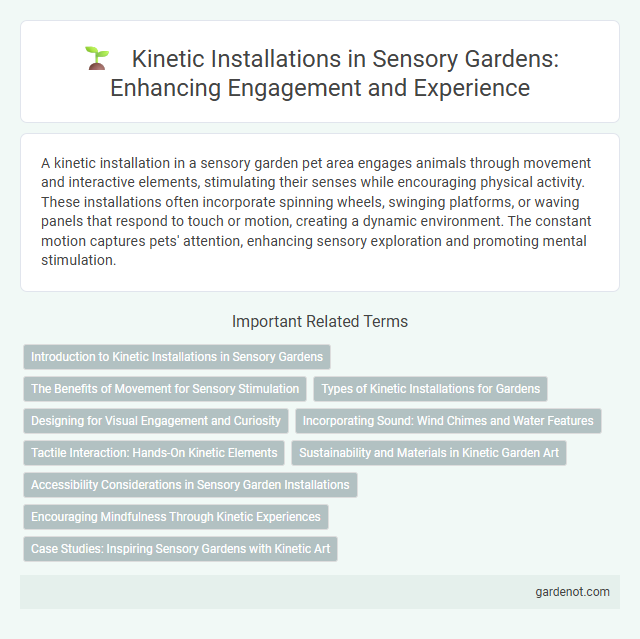A kinetic installation in a sensory garden pet area engages animals through movement and interactive elements, stimulating their senses while encouraging physical activity. These installations often incorporate spinning wheels, swinging platforms, or waving panels that respond to touch or motion, creating a dynamic environment. The constant motion captures pets' attention, enhancing sensory exploration and promoting mental stimulation.
Introduction to Kinetic Installations in Sensory Gardens
Kinetic installations in sensory gardens engage visitors through movement, light, and sound, stimulating multiple senses to create interactive environments. These dynamic structures often incorporate wind, water, or human touch to generate patterns and rhythms, enhancing sensory experiences for all ages and abilities. Such installations support therapeutic, educational, and recreational purposes by encouraging exploration and sensory integration.
The Benefits of Movement for Sensory Stimulation
Kinetic installations in sensory gardens provide dynamic movement that enhances sensory stimulation by engaging multiple senses simultaneously, including sight, touch, and hearing. The continuous motion of elements such as spinning wheels, pendulums, or wind chimes stimulates neural pathways and improves sensory integration, benefiting individuals with sensory processing disorders. Movement-based interactions promote increased focus, relaxation, and cognitive development through active participation and multisensory engagement.
Types of Kinetic Installations for Gardens
Types of kinetic installations for sensory gardens include wind-driven sculptures, water-based moving features, and interactive mechanical devices that respond to touch or motion. Wind-driven sculptures utilize the natural breeze to create dynamic visual interest, while water installations often incorporate flowing or cascading elements that produce soothing sounds. Interactive mechanical devices engage visitors by activating movement through buttons, levers, or sensors, enhancing sensory stimulation and garden immersion.
Designing for Visual Engagement and Curiosity
Kinetic installations in sensory gardens captivate visitors through dynamic movement and interactive elements that stimulate visual engagement and curiosity. Incorporating materials such as reflective surfaces, vibrant colors, and motion-triggered lighting enhances the garden's sensory appeal, encouraging prolonged exploration. Strategic placement along pathways and near focal points ensures these installations foster an immersive, multisensory experience that invites continuous discovery.
Incorporating Sound: Wind Chimes and Water Features
Kinetic installations in sensory gardens enhance auditory experiences by integrating wind chimes and water features that respond to natural movements like breeze and water flow. Wind chimes produce varying tones as they sway, creating soothing melodies that stimulate auditory senses and encourage relaxation. Water features add dynamic sound elements through flowing or dripping water, promoting a calming atmosphere and engaging visitors with tactile and sound interactions.
Tactile Interaction: Hands-On Kinetic Elements
Hands-on kinetic elements in sensory gardens enhance tactile interaction by encouraging visitors to physically engage with moving parts, promoting sensory stimulation and motor skills development. These installations often incorporate rotating wheels, levers, or pulleys made from varied textures and materials, providing diverse tactile feedback. Integrating kinetic features enriches the sensory experience, making the garden accessible and stimulating for individuals of all ages and abilities.
Sustainability and Materials in Kinetic Garden Art
Kinetic installations in sensory gardens utilize sustainable materials such as recycled metals, bamboo, and weather-resistant composites to minimize environmental impact. These materials are chosen for durability, low maintenance, and their ability to harness natural forces like wind and water, promoting eco-friendly energy use. By integrating sustainable craftsmanship, kinetic garden art enhances sensory engagement while supporting environmental stewardship.
Accessibility Considerations in Sensory Garden Installations
Kinetic installations in sensory gardens incorporate accessibility features such as adjustable heights and tactile feedback elements to engage users with diverse physical abilities. These designs optimize interactive movement through smooth, low-resistance mechanisms that accommodate wheelchair users and individuals with limited dexterity. Incorporating multisensory elements, like sound and vibration, ensures an inclusive experience that stimulates various senses beyond visual engagement.
Encouraging Mindfulness Through Kinetic Experiences
Kinetic installations in sensory gardens create dynamic environments that engage multiple senses, encouraging mindfulness through movement and interaction. The gentle motion of wind-driven sculptures or interactive elements stimulates visual and tactile awareness, fostering a meditative state. These sensory experiences promote presence and relaxation by connecting visitors to natural rhythms and subtle energy flows within the garden.
Case Studies: Inspiring Sensory Gardens with Kinetic Art
Kinetic installations in sensory gardens integrate movement and interactive elements to engage multiple senses, enhancing visitor experience through dynamic art. Case studies like the Chicago Botanic Garden's "Wind Waves" exemplify how wind-activated sculptures create immersive environments that encourage touch, sight, and sound interaction. Such installations foster therapeutic benefits and stimulate sensory exploration, making them vital features in contemporary sensory garden design.
Kinetic installation Infographic

 gardenot.com
gardenot.com